

|
Soundclip:
|
| See Steve's Hand-Written Solo transcription |
|
Wes Montgomery's
chord solo on: 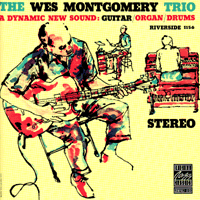 The recording only featured two of Wes' blues-based originals: "Missile Blues" and "Jingles." The other 6 tunes were standards from such respected composers as: Duke Ellington; Horace Silver; Benny Golson; Jerome Kern; Lerner & Lane; and the incredible Thelonious Monk's ballad standard, "'Round Midnight." As each interpretation bears the unique Montgomery personal stamp, it is most obvious just how familiar all the players were with one another and their arrangements. For me, as a listener, as a fan, these are huge elements. The recording only featured two of Wes' blues-based originals: "Missile Blues" and "Jingles." The other 6 tunes were standards from such respected composers as: Duke Ellington; Horace Silver; Benny Golson; Jerome Kern; Lerner & Lane; and the incredible Thelonious Monk's ballad standard, "'Round Midnight." As each interpretation bears the unique Montgomery personal stamp, it is most obvious just how familiar all the players were with one another and their arrangements. For me, as a listener, as a fan, these are huge elements.Because of the tremendous response I have received to our recent presentation of Wes' chordal solo, which appears on his interpretation of Antonio Carlos Jobim's gorgeous "Once I Loved", I decided to present another Montgomery chordal solo. This one appears only during the [B] section of the aforementioned "'Round Midnight" by Thelonious Monk. The two letter [A] sections, which precede the chord solo, are played completely in octaves, so as the bridge arrives, the chord solo provides a nice change of texture and sound. Chordal soloing, on the acoustic piano a` la Bill Evans, sounds very graceful with the skillful and subtle usage of the sustain pedal. The guitar has no such luxuries to swallow-up the spaces that must naturally exist between each voicing. So, even with a player of Montgomery's grace can sound a bit stiff when executing passages like these. But, he performs about as smoothly as anyone could have. With that in mind, for this solo analysis, I have decided to address what Wes played in 2-bar units and hopefully, in doing this, it will maximize what everyone can gain from studying this masterful 8-bar portion of a one-chorus solo. One of the most enduring traits about the music of Thelonious Monk is that, virtually all the players, who become enamored with his compositions, choose to alter the basic changes he established. So, for this simple 8-bar [B] section, Monk originally played it using these changes: || Cm7b5 / F7(alt.) / | Bb7(b5) / / / | Cm7b5 / F7(alt.) / | Bb7(b5) / / / | | Abm7 / Bb7(alt.) / | Ebm7 / F7(alt.) / | Abm7 Db7(13) Gbm7 B7(13) | Fm7b5 / Bb7(b5) / || Perhaps my absolute favorite interpreter of Thelonious Monk is Chick Corea, here is how he treats [B] on his wonderful "TRIO MUSIC" recording which featured Miroslav Vitous(Ac. Bass) and Roy Haynes(Drums): || Cm7b5 / F7(alt.) / | Bb7(b5) / / / | Cm7b5 / F7(alt.) / | Bb7(b5) / / / | | Abm7 / Db7(9) / | Cm7b5 / F7(alt.) / | Bbm7 Eb7 Abm7 Db7| Gbm7 B7 Fm7b5 Bb7(alt.) || It's also worth noting that Chick Corea plays bars 3-4, later in his arrangement in the following way: || Cm7b5 / F7(alt.) / | Bb7(b5) / / / | Fm7(sus) / / / | F#m7 / B7 / | But, what Wes Montgomery does, for his solo changes, to letter [B] is the following: || F#m7 / B7 / | Fm7 / Bb7 / | F#m7 / B7 / | Fm7 / Bb7 / | | Abm7 / Db7(alt.) / | Gbmaj7 / B7(13) / | Abm7 Db7 Gm7 C7 | F#m7 B7 Fm7 Bb7(alt.) || It is absolutely fascinating to see how these three great players, including the composer, could treat bars 5-8 in such completely differing ways. And, for each player, bars 7-8 are so radically different that one might not even recognize what is going on. Other than the fact that the chord always descend towards the eventual Bb7(alt.) chord, but in very different ways. My discussion of just what Wes was doing when he improvised with chords is going to be, from this point forward, very 'guitar-centric' and, perhaps not of great appeal to those who play other instruments. Compared to the piano, the guitar, when played in this older, more traditional style, can seem rather simple, almost primitive. 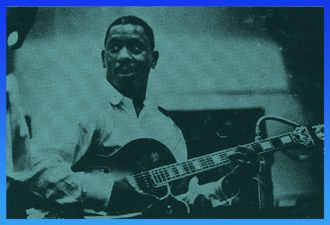 But, whether that is one's perspective or not, for guitarists of all ages it is more than worth the time for study, analysis, and personal practice and execution. Though I feel that, considering this was Wes Montgomery's first recording as a leader, he should have felt very comfortable being surrounded by his longtime friends and bandmates. I would also hasten to point out that the accompaniment style of organist, Mel Rhyne shows a great sensitivity to and knowledge of Wes' style. The subtlety and understanding which Rhyne offers while playing underneath Wes' chords demonstrates exactly that. Often times, players view and even incorrectly 'hear' the guitar as an instrument high in register. Nothing could be further from the truth. And sometimes, we guitarists must be mindful of this, and never forget that fact! For those of you who might be new to looking at guitar music written-out on the staff, you must remember that the guitar is a transposing instrument and the notes on the page appear one octave higher than where they actually sound. So, were you to play these same passages on the piano, in the correct register? They might sound very dark. And, this alone would give you pause for thought and then praise for how Mel Rhyne tucks himself beneath these voices. He does it with his volume at a pianissimo level, and leaving the proper space for Wes to do "his thing." Now, let's get to each 2-bar unit of the 8-bar [B] section. But, whether that is one's perspective or not, for guitarists of all ages it is more than worth the time for study, analysis, and personal practice and execution. Though I feel that, considering this was Wes Montgomery's first recording as a leader, he should have felt very comfortable being surrounded by his longtime friends and bandmates. I would also hasten to point out that the accompaniment style of organist, Mel Rhyne shows a great sensitivity to and knowledge of Wes' style. The subtlety and understanding which Rhyne offers while playing underneath Wes' chords demonstrates exactly that. Often times, players view and even incorrectly 'hear' the guitar as an instrument high in register. Nothing could be further from the truth. And sometimes, we guitarists must be mindful of this, and never forget that fact! For those of you who might be new to looking at guitar music written-out on the staff, you must remember that the guitar is a transposing instrument and the notes on the page appear one octave higher than where they actually sound. So, were you to play these same passages on the piano, in the correct register? They might sound very dark. And, this alone would give you pause for thought and then praise for how Mel Rhyne tucks himself beneath these voices. He does it with his volume at a pianissimo level, and leaving the proper space for Wes to do "his thing." Now, let's get to each 2-bar unit of the 8-bar [B] section.If you need a reminder as to how Wes has altered Monk's usual chord changes for the first 4 bars of [B], just remember to consult Monk's changes which I have offered above. Even for me, it is a bit strange to hear the sounds of F#m7 instead of the traditional Cm7b5. Virtually all the m7 and dominant 7th voicings, that you will hear Wes using, are very, very common to virtually all guitarists who have spent time studying Jazz harmony on the guitar. The solo begins with Wes' favorite voicing when playing over a m7 chord with the 5th, C# in this case, on top. But, before I go any further. After this transcription had been up on the Web for awhile, I received an e-mail via the site from another Wes admirer who pointed out, and correctly so, that the top voice of the chord Wes played on beat 3 of bar 1 was, in fact, a G-natural, and not the G# that you see written. He questioned me about this, and I responded in the following manner. As I am a long time student of Wes' work, sometimes even great, great players make mistakes, especially in the studio, and this was his first recording as a leader. So, as the transcriber, sometimes, I choose to write what I believe the player was actually attempting to play. And, the voicings that I wrote, I believe, and firmly so, that Wes meant to play those two voicings on beat 3 and on the and-of-3. They are the most typical for him, and the most characteristic of his style when playing over a non-resolving ii-V like this. I know that in past analyses, I have pointed out that this the way I approach writing-out a transcription. Others might not agree with this, and believe that one must always write out literally what the player actually played. Sometimes, I adhere to that too, but in this case, "No!" So now, let us continue. Instead of playing through chord changes like this in a completely diatonic manner, Wes often inserts diminished voicings while passing between chords in the same family. Here, within beat 2, you see B-natural on top, which is in the F# Dorian mode(F#, G#, A, B, C#, D#, E), but that note is harmonized with the aforementioned diminished voicing. The chord formation that begins bar 2, could be labeled as either B7(9sus) or Fm7(sus). Either way, it is the same thing. But, on beat 2 of this same bar, the voicing resolves to B7(9). This type of inner-voice movement is very common to our instrument. As bar 3 begins, knowing that we are about to see a repeat of the chord changes that appear in bars 1 and 2, Wes plays a phrase which is ascending, as if in response to the initial phrase which descended. It begins with the very traditional m7 voicing with the m3rd on top, and, once again, in between the m7 voicing with the 5th on top, you see the same diminished chord with B-natural on top. Leading into the two diminished chords that appear on beat 2 is an average C7 voicing with the 3rd on top. One might have expected this to resolve down 1/2-step to B7 with the 3rd on top, but, that doesn't happen here. On beat 3, all three voicings are completely diatonic and within the F# Dorian mode. As bar 4 begins, Wes slides into, yet again, his favorite voicing for a m7 with the 5th on top. But, this time, as the passage descends, we see the same diminished voicing in sequence, here with Bb on top, and then, what might have been an error. Normally, I would have expected to see the m7 voicing with the m3rd(Ab) on top, but here, and you hear Wes' fingers sliding around, my ears tell me that this became a 3-note augmented voicing with Ab(G#) on top. I suppose it could be explained away as being part of a C augmented triad. On beat 2, as the passage descends through G-F-Eb-D as the top voices for each chord, these voicings are all diatonic except the voicing on the 3rd 16th-note, which is really the guts of an Ab7 chord. This resolves on the last 16th-note to a 3-note cluster which is part of B7(9). On beats 3 and 4 of bar 4, knowing that an Abm7 chord is coming up in bar 5, Wes uses a diminished sequence with the top voices outlining an arpeggio with notes within the sounds of Eb7(b9). This is, of course, the V7 chord of Abm7, and this is what savvy players do, anticipate the chord to which you are headed. Even if it is not indicated within the bar in which you are presently playing!!! This diminished(7b9) passage resolves strangely, at least to me, on the 3rd 16th-note of beat 4, to what appears to be an Am7 voicing with the m3rd on top. Yes, it is 1/2-step above where we are headed, Abm7, but, it is a little unusual to me. Is it possible that this might have been an error? Yes, it is possible as even the greats can make an error. As bar 5 begins, again, Wes puts to use the same simple m7 voicings, this time over Abm7, and with the m3rd on top up to the 5th. On the 2nd-half of beat 1, his top voice moves down from the 9th(or 2nd) to the root. This, of course, is all done by simply releasing one's pinky which had been playing the Bb(the 9th). On beat 2 of bar 5, he plays, what I would describe as an 'inside voicing' - meaning that there is no top voice on your high E-string - with Gb on top on the B-string. Then, from 1/2-step below, Wes slides up, using a 3-note voicing, to the Db7(9). Again, he's employing a cluster which is easy to do, in this configuration on the guitar. On beat 4, Wes uses a voicing for Db7(#5) where the 3rd is doubled and also appears as the top voice. From there, the resolution to the Imaj7 chord(Gbmaj7/9) moves from #9-b9 before the actual resolution on beat 1 of bar 6. The voicing with the #9 is a little unusual for Wes as it also contains, to these ears, the natural 13(Bb). 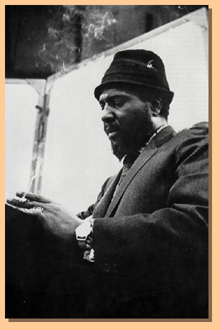 Normally, on the inside, I would expect to hear the #5(A-natural/G double-sharp). Before the IV7(B7) chord arrives, on beat 2 we find another diminished sequesnce which is really, in this case, function as Gbmaj7 become Gb7(b9) which makes it a V7 of a V7. This kind of harmonic manipulation is very, very common for an experienced Jazz player, an improvisor. The point of resolution is a very simple, ordinary B7 voicing with the root on the bottom(his low E-string) though that voice is not clearly heard here. Normally, on the inside, I would expect to hear the #5(A-natural/G double-sharp). Before the IV7(B7) chord arrives, on beat 2 we find another diminished sequesnce which is really, in this case, function as Gbmaj7 become Gb7(b9) which makes it a V7 of a V7. This kind of harmonic manipulation is very, very common for an experienced Jazz player, an improvisor. The point of resolution is a very simple, ordinary B7 voicing with the root on the bottom(his low E-string) though that voice is not clearly heard here.In bars 7-8 of the [B] section for "'Round Midnight" in just about any interpretation, you will be confronted with some sequence of descending dominant 7th chords, or non-resolving iim-Vs. Where Wes Montgomery's version differs is that you find the iim-Vs descending chromatically. As Wes changes positions on the instrument and is now nearer the 12th fret, his melody note over the Abm7 chord is the m3rd(Cb), and he plays a voicing which places an Eb on his low E-string. This is answered by a very traditional Db7(9/13) voicing with the 9th(Eb) on top. Now, on beat 3 and over Gm7-C7, Wes passes from a Gm7 voicing which is the same one he used for Abm7, but this time a D-natural is playing on his low E-string. From here, another diminished voicing(with C-natural on top) is sandwiched between the higher Gm7 voicing with D-natural on top. On beat 4, he again, uses 3-note voicings, a Gm7(9) with the 9th(A) on top down to a C7 chord with the 5th(G) on top. The F#m7 for bar 8 is anticipated by a 16th-note, and the chord voicing has an A-natural on top, with that m3rd being doubled inside. J.S. Bach would not have approved of this!!! At least that's what they tried to hammer into my mind in music school at U.C.L.A.!!! On beat 1 of bar 8, the descending passage from E-D#-C# in the top voice of each chord, you might expect to hear consonant m7 voicings, but not so fast!!! The first voicing with E-natural on top is actually a little C7 chord which is followed by, what we will label as, D#°7 which resolves finally to F#m7 with C#(the 5th) on top. On beat 2, the 3-note voicings return, appearing across your D to B-strings. Again, you have F#m7(9) with G#(9th) on top, followed by B7 chords with F#(the 5th) on top. The stream of 16th-note chord voicings continues through beats 3 and 4 of bar 8 with, yet again, another curious voicings on the 2nd 16th-note. The top voice of Eb is certainly a chord tone, the 7th degree of Fm7. But, it is harmonized with a chord voicing that could be best described as Abm7 with the fifth(Eb) on top. It is immediately followed by the same voicing, in parallel, in Fm7 with C-natural on top. From there Wes descends in his own very traditional way with the top voices descending C-Ab-G-F. The F-natural is harmonized from below as a simple B7 voicing. Again, Wes anticipates the arrival of the Ebm7 chord for what will be beat one a return to [A], and the top of the tune. It is not uncommon, especially when recording a ballad for an LP, to save time by eliminating a section to get back to the melody faster. In this case, the final [A3] of "'Round Midnight" gets skipped. This is something that probably only a musician would notice. But, even having noticed it, that person would quickly adapt and adjust his/her thinking. Wes uses a nice voicing for Ebm7, which many guitarists might look at and think of, in this case, as Ab7(13/9). Spelling up, from you D-string, you would have: Gb-C-F-Bb. But, when the bass is playing an Eb, the labeling of this chord becomes: Ebm6(9). It gives the sonority a great sense of mystery. You often hear the great pianist, McCoy Tyner do this on beat 1 for many m7 chords. You can hear this in his playing behind the great John Coltrane throughout their association. As I was listening to the entire performance, I was struck by the fact that Wes had come-up with a very nice 4-bar Introduction, an [I] section to the tune. And so, I decided to write that out as well. I think that it is just as important, at times, to make the extra effort, in personalizing any piece that you are going to interpret, by coming up with an Introduction as well as an ending, a [Tag] instead of relying on a Fade. Obviously, in live performance it gives the piece a sense of finality! Notice how Wes Montgomery has employed the illusion of using the actual song form changes, which does set-up the mood for the entire song, and to me, this is crucial! What is so nice is that, when he cadences on bar 4, he uses the Ebmaj7 chord in place of the Ebm7 which is where we are eventually headed and is the sonority associated with this famous Jazz standard. He arrives at Ebmaj7 by passing through E7(9b5) after a ii-V cadence to Gbmaj7. It's beautifully done by a trio which had been playing together, no doubt, for years and years!!! From the sound of what Wes plays during this 4-bar Intro, it seems highly possible that some of it might be more 'composed' than improvised. During the 1st 2-bars, over the m7 chords, he outlines very typical m7 arpeggios. In bar 2, on beat 4 as he cadences through Abm7-Db7(alt.) to Gbmaj7, 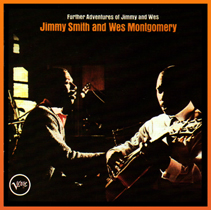 this line passes through the #5-3rd-#9-b9 notes which is very typical altered line cadence. In bar 3, there is, at least to these ears, a rather strange choice of notes over the E7(9b5) sonority which is passing through to cadence on Ebmaj7(9). Here, you would expect to see/hear notes from the E Lydian b7 scale[E, F#, G#, Bb(A#), B, C#, D], and this scale contains the exact same notes as the Bb altered dominant scale: Bb, B, Db, D, E, F#, Ab. However, the appearance of a D#(the major 7th) is most strange to me. But, when played with conviction, it sounds fine. I have no great explanation as to why that is. But, though a D# is the major 7th of what is a dominant 7th type chord/sonority, it is, at the very least, the root[R] of the Ebmaj7, the chord to which you are headed! As Wes makes his final cadence to Ebm9(6) and the beginning of Monk's classic opening melodic phrase, over the Bb7(alt.) chord, he employs a fast little line, which outlines the Eb harmonic minor scale. This is a most common device when cadencing to minor!!! It is crucial to know and understand this scale, and in this context! this line passes through the #5-3rd-#9-b9 notes which is very typical altered line cadence. In bar 3, there is, at least to these ears, a rather strange choice of notes over the E7(9b5) sonority which is passing through to cadence on Ebmaj7(9). Here, you would expect to see/hear notes from the E Lydian b7 scale[E, F#, G#, Bb(A#), B, C#, D], and this scale contains the exact same notes as the Bb altered dominant scale: Bb, B, Db, D, E, F#, Ab. However, the appearance of a D#(the major 7th) is most strange to me. But, when played with conviction, it sounds fine. I have no great explanation as to why that is. But, though a D# is the major 7th of what is a dominant 7th type chord/sonority, it is, at the very least, the root[R] of the Ebmaj7, the chord to which you are headed! As Wes makes his final cadence to Ebm9(6) and the beginning of Monk's classic opening melodic phrase, over the Bb7(alt.) chord, he employs a fast little line, which outlines the Eb harmonic minor scale. This is a most common device when cadencing to minor!!! It is crucial to know and understand this scale, and in this context!What I like the most of Wes Montgomery's interpretation of Monk's oft-played ballad, "'Round Midnight" is that he treats it as a work of great beauty. It has always been my feeling, when interpreting Monk's music, and the tempo or the melodic content does not dictate this to me, I always try to find what is "romantic" within the tune. But also, I try to locate what is "humorous" within the piece. Those two elements coupled with what is naturally in there within Monk's playing is the rather child-like nature of the way he attacks the piano. These three elements, in total, do not have to dominate your own excursions into Monk's music, but, they should be incorporated into your approach. This is why I have always felt that Chick Corea is a such a great interpreter of the music of Thelonious Monk. He sees and understands all these elements and they have a way of filtering into each and every performance. If I have a criticism of Wes' interpretation, it is that he is missing the elements of humor. When you listen to Monk playing this same tune, and he recorded it multiple times, you always hear dissonant intervals(both major and minor 2nds) thrown-in here and there. 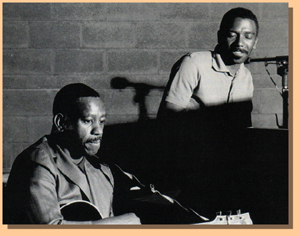 And, of course, his usage of whole-tone scales, which can appear over any dominant 7th chord, usually descending rapidly, but, in this tune, especially over the Bb7(b5) chords, that appear in bars 2 & 4 of letter [B]. Again, if you can access Chick's trio version of this tune, you will hear these elements liberally placed within! Don't miss it!!! And, of course, his usage of whole-tone scales, which can appear over any dominant 7th chord, usually descending rapidly, but, in this tune, especially over the Bb7(b5) chords, that appear in bars 2 & 4 of letter [B]. Again, if you can access Chick's trio version of this tune, you will hear these elements liberally placed within! Don't miss it!!!As I went back through my LP/CD collection before closing out this analysis, I was reminded that Wes Montgomery had recorded yet another version of "'Round Midnight" with organist, Jimmy Smith in September of 1966 on their 2nd LP together, which was titled, "FURTHER ADVENTURES OF JIMMY AND WES" and the performance features a very brassy arrangement by the great Oliver Nelson. Of course, I wanted to revisit this version to see just how they treated letter [B], but before I ever got that far, I was a bit surprised to hear that they had decided to play the tune in F-minor, and not the familiar Thelonious Monk key of Eb-minor. Of course, I have no idea why this would have been so, but, speculation, on my part, would lead me to believe that, perhaps, Jimmy Smith felt more comfortable playing it in F-minor? Again, it's just a guess. The Oliver Nelson treatment of the first 4 bars of [B] is as one might expect, closer to the original Monk changes, but, one whole-step higher because of the key change to F-minor. However, there is an interesting little twist in bars 5-8 as the brass section joins in. However, during the solo sections in bars 7-8, the descending progression returns to the more traditional Bbm7-Eb7 Abm7-Db7, and Gm7sus-C7(alt.) for a full bar. || Dm7b5 / G7(alt.) / | C7(b5) / / / | Dm7b5 / G7(alt.) / | C7(b5) / / / | | Bbm7 / Eb7 / | Dm7b5 / G7 / | Ebm7(9) Ab7(13b9) Dbm7 Gb7(13b9) | Bm7 E7(13b5) Gm9sus C7(alt.) || As I stated once before, it is my great hope that, by making this chord solo transcription available here, the multitude of guitarists looking to improve and broaden their chordal knowledge can break these passages down, and begin to put them to use in their own playing. I am not, in any way, shape or form, advocating that anyone copies these voicings or this Wes Montgomery voicing style. But, from a historical perspective, and for anyone's desire of wanting to work towards some form of comprehensive mastery of the instrument as a Jazz voice, you can't have been handed a better set of tools. 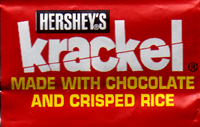 So, as I always seem to say, take things slow-ly, break things down into small units that can be accomplished. And, in the end, you will reap the benefits of having the full project assimilated into your consciousness!!! I've seen it happen before, and it can easily happen again, and for you! Keep a small and short focus for the best results!!! So, as I always seem to say, take things slow-ly, break things down into small units that can be accomplished. And, in the end, you will reap the benefits of having the full project assimilated into your consciousness!!! I've seen it happen before, and it can easily happen again, and for you! Keep a small and short focus for the best results!!!And, as another HALLOWEEN comes and goes, I was reminded that the Krackel® bar by Hershey's is longer being made! It now only appears as part of the Hershey's miniatures package. HOW could this have happened? I guess it couldn't compete with Nestle's Crunch bar? But, let us not forget who was copying who? Anyway, this was a most distressing development, even though it happened a few years ago. I'm always behind the times when it comes to these huge events!!!!
[Photo: Wes Montgomery and his Gibson L-5 in 1959
Photo by: Steve Schapiro Photo: Thelonious Monk Photo by: Lawrence Shustak Photo: Wes Montgomery and Jimmy Smith Photo by: Chuck Stewart] |